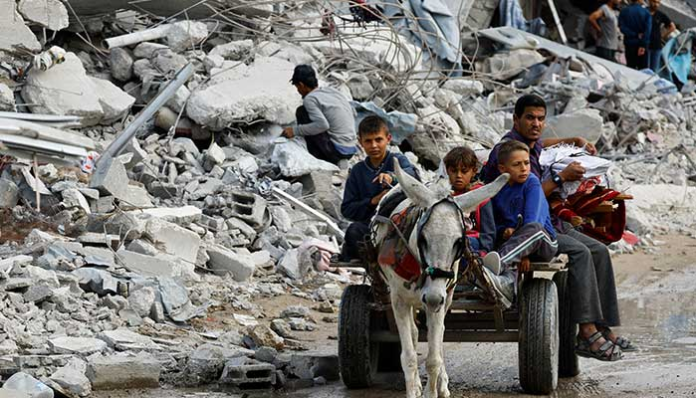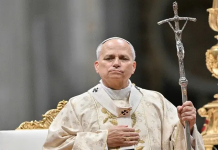Without a major push by US to break impasse, yellow line looks set to become de facto border indefinitely dividing Gaza
MANAMA: A de facto partition of Gaza between an area controlled by Israel and another increasingly likely, multiple sources said, with efforts to advance US President Donald Trump’s plan to end the war beyond a ceasefire faltering.
Six European officials with direct knowledge of the efforts to implement the next phase of the plan told Reuters it was effectively stalled and that reconstruction now appeared likely to be limited to the Israel-controlled area. That could lead to years of separation, they warned.
Under the first stage of the plan, which took effect on October 10, the Israeli military currently controls 53% of the Mediterranean territory, including much of its farmland, along with Rafah in the south, parts of Gaza City and other urban areas.
Nearly all Gaza’s two million people are crammed into tent camps and the rubble of shattered cities across the rest of Gaza.
Reuters drone footage shot in November shows cataclysmic destruction in the northeast of Gaza City after Israel’s final assault before the ceasefire, following months of prior bombardments. The area is now split between Israeli and Hamas control.
The next stage of the plan foresees Israel withdrawing further from the so-called yellow line agreed under Trump’s plan, alongside the establishment of a transitional authority to govern Gaza, the deployment of a multinational security force meant to take over from the Israeli military, the disarmament of Hamas and the start of reconstruction.
But the plan provides no timelines or mechanisms for implementation. Meanwhile, Hamas refuses to disarm, Israel rejects any involvement by the Western-backed Palestinian Authority, and uncertainty persists over the multinational force.
“We’re still working out ideas,” Jordanian foreign minister Ayman Safadi said at a Manama security conference this month. “Everybody wants this conflict over, all of us want the same endgame here. Question is, how do we make it work?”
Without a major push by the US to break the impasse, the yellow line looks set to become the de facto border indefinitely dividing Gaza, according to 18 sources, among them the six European officials and a former US official familiar with the talks.
The US has drafted a UN Security Council resolution that would grant the multinational force and a transitional governing body a two-year mandate. But ten diplomats said governments remain hesitant to commit troops.
European and Arab nations, in particular, were unlikely to participate if responsibilities extended beyond peacekeeping, and meant direct confrontation with Hamas or other Palestinian groups, they said.
US Vice President JD Vance and Trump’s influential son-in-law Jared Kushner both said last month reconstruction funds could quickly begin to flow to the Israel-controlled area even without moving to the next stage of the plan, with the idea of creating model zones for some Gazans to live in.
Such US proposals suggest the fragmented reality on the ground risks becoming “locked into something much more longer term,” said Michael Wahid Hanna, US programme director of think-tank International Crisis Group.
A State Department spokesperson said that while “tremendous progress” had been made in advancing Trump’s plan, there was more work to do, without responding to questions about whether reconstruction would be limited to the Israeli-controlled area.
Prime Minister Benjamin Netanyahu has said Israel has no intention of re-occupying or governing Gaza, even though far-right ministers in his cabinet have urged the revival of settlements dismantled in 2005.
The military, too, has resisted such demands for a permanent seizure of the territory or direct oversight of Gaza’s civilians. Netanyahu has instead pledged to maintain a buffer zone within Gaza, along the border, to block any repeat of Hamas’ October 2023 attack.
Yellow line
Israeli forces have placed large yellow cement blocks to demarcate the withdrawal line and is building infrastructure on the side of Gaza its troops control. In the Shejaiya neighbourhood of Gaza City, the military took journalists last week to an outpost fortified since the ceasefire.
There, satellite images show, earth and building rubble have been bulldozed into steep mounds, forming a protected vantage point for soldiers. Fresh asphalt has been laid.
Israel’s military spokesman Nadav Shoshani said Israel would move further from the line once Hamas met conditions including disarming and once there was an international security force in place.
As soon as “Hamas holds their part of the agreement we are ready to move forward,” Shoshani said. An Israeli government official, responding to written questions for this article, said Israel adhered to the agreement and accused Hamas of stalling.
Hamas has released the last 20 living hostages held in Gaza and the remains of 24 deceased hostages as part of the first stage of the plan. The remains of four other hostages are still in Gaza.
Nearby, in Palestinian areas of the city, Hamas has reasserted itself in recent weeks. It has provided police for security and civil workers who guard food stalls and clear paths through the broken landscape using battered excavators, Reuters video shows.
“We really need to fill the vacuum within the Gaza Strip for security,” German Foreign Minister Johann Wadephul said at the Manama conference, urging speed and warning a Hamas resurgence could trigger renewed Israeli military operations in Gaza.
Hazem Qassem, a Hamas spokesperson in Gaza City, said that the group was ready to hand over power to a Palestinian technocrat entity so that reconstruction could begin.
“All the regions of Gaza deserve reconstruction equally,” he said.
One idea under discussion, according to two European officials and a Western diplomat, was whether Hamas could decommission weapons under international supervision rather than turn them over to Israel or another foreign force.
European and Arab states want the West Bank-based Palestinian Authority and its police to return to Gaza alongside the multinational force to take over from Hamas.
Thousands of its officers trained in Egypt and Jordan are ready for deployment, but Israel opposes any involvement by the Palestinian Authority.
Rebuilding under Israel’s occupation
The six European officials said that absent a major shift in Hamas’ or Israel’s positions, or US pressure on Israel to accept a role for the Palestinian Authority and path to statehood, they did not see Trump’s plan advancing beyond the ceasefire.
“Gaza must not get stuck in a no man’s land between peace and war,” Britain’s Foreign Secretary Yvette Cooper said at the Manama conference.
Gaza City resident Salah Abu Amr, 62, said that if no progress was made on disarming Hamas and redevelopment began across the yellow line, people might think of moving there. But the realities of a divided Gaza were hard to contemplate, he said.
“Are we all going to be able to move into that area? Or Israel will have a veto over the entry of some of us,” he said. “Are they also going to divide the families?”
It remains unclear who would finance rebuilding parts of Gaza under Israeli occupation, with Gulf nations loath to step in without involvement of the Palestinian Authority and a path to statehood, resisted by Israel.
$70bn reconstruction cost
Reconstruction costs are estimated at $70 billion. Any de facto territorial breakup of Gaza would further set back Palestinian aspirations for an independent nation including the West Bank and worsen the humanitarian catastrophe for a people without adequate shelter and almost entirely dependent on aid for sustenance.
“We cannot have a fragmentation of Gaza,” Jordan’s Safadi said. “Gaza is one, and Gaza is part of the occupied Palestinian territory.”
Palestinian Foreign Minister Varsen Aghabekian Shahin also rejected territorial division of Gaza, and said the Palestinian Authority was ready to assume “full national responsibility”.
“There can be no genuine reconstruction or lasting stability without full Palestinian sovereignty over the territory,” she said in a statement in response to Reuters questions.

















